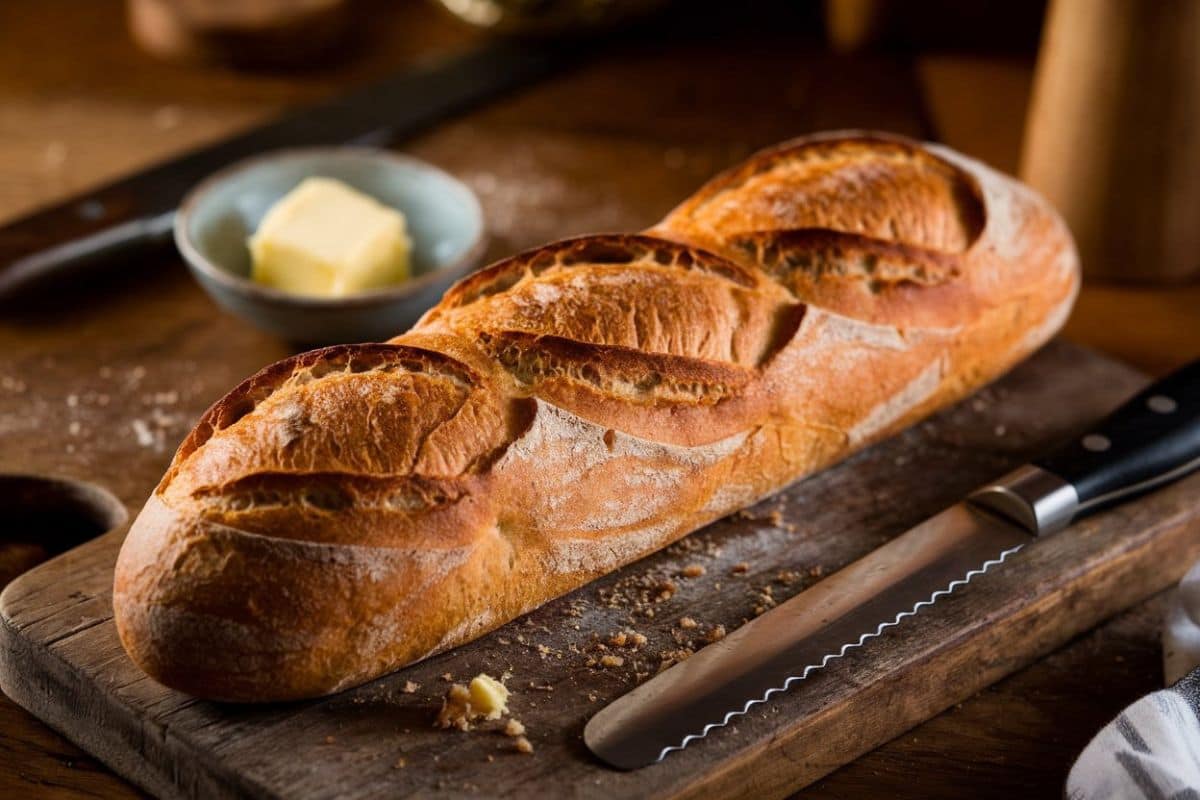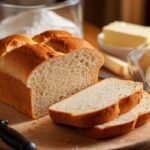There’s nothing quite like the taste of fresh, homemade French bread – the crispy golden crust, soft fluffy interior, and that irresistible aroma that fills your kitchen. While French bread (commonly known as a baguette) is a staple in France, you don’t have to be a professional baker or travel to France to enjoy a delicious loaf. With the right technique and ingredients, you can bake authentic, bakery-quality French bread at home.
In this article, we’ll walk you through an easy homemade French bread recipe. We’ll cover everything from selecting ingredients to mastering the kneading process, shaping the dough, and achieving that perfect golden crust. Whether you’re new to baking or a seasoned pro, this guide will help you bake the best French bread with ease.
Introduction to French Bread
French bread, especially the baguette, has been a cherished part of French culture for centuries. Renowned for its crunchy crust and elongated form, and soft interior, French bread is often used in everything from sandwiches to dipping into soups and sauces. This bread’s simplicity is what makes it so beautiful – it’s made from basic ingredients like flour, water, yeast, and salt, yet yields such rich flavor and texture.
While French bread may seem intimidating to make, the process is actually quite simple. By following this easy French bread recipe, you’ll be able to bake your own loaves with confidence, and enjoy the satisfaction of creating this iconic bread from scratch.
Ingredients for Homemade French Bread
To create authentic French bread, you’ll only need a handful of ingredients. However, the quality and balance of these ingredients have an important effect on the final result. Here’s what you’ll need:
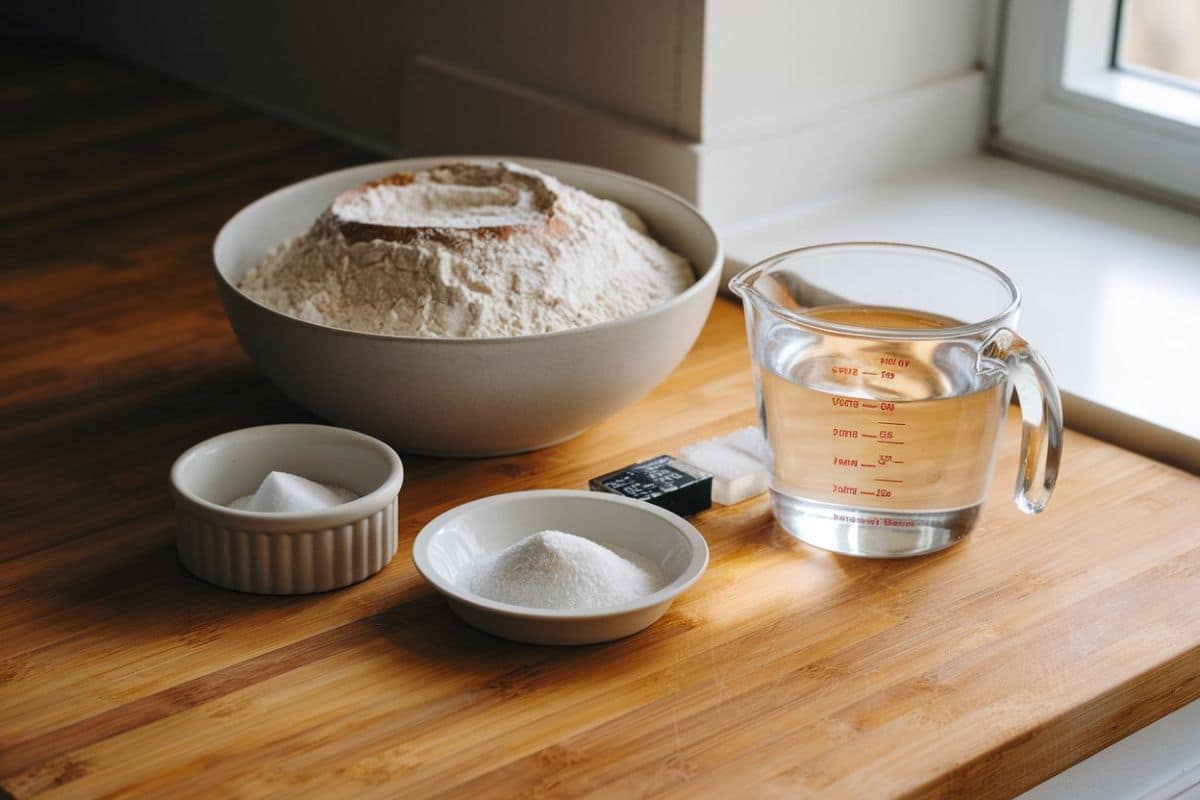
Ingredients:
- 4 cups of all-purpose flour (or bread flour for a chewy texture)
- 1 ½ cups of warm water (about 110°F or 45°C)
- 1 packet (2 ¼ teaspoons) of active dry yeast
- 2 teaspoons of sugar
- 2 teaspoons of salt
- 1 tablespoon of olive oil (optional, for added flavor)
These ingredients form the foundation of a traditional French bread recipe, allowing you to craft a loaf with perfect texture and flavor.
Tools You’ll Need for This French Bread Recipe
Having the right tools can make the bread-making process smoother. Here’s what you’ll need for this recipe:
- Mixing bowl: For combining the ingredients.
- Use measuring spoons and cups: To measure ingredients precisely,
- Baking sheet or baguette pan: A baguette pan is ideal for shaping, but a baking sheet works just as well.
- Sharp knife or bread lame: To score the top of the bread before baking.
- Clean kitchen towel: For covering the dough while it rises.
- Stand mixer (optional): If you want to avoid kneading by hand.
- Spray bottle of water: To create steam in the oven for a crispy crust.
Also Read: Simple Sandwich Bread Recipe | Homemade Bread for Every Meal
Step-by-Step French Bread Recipe
Now, let’s dive into the actual process of making homemade French bread. Follow this step-by-step guide, and you’ll have fresh, warm bread in no time.
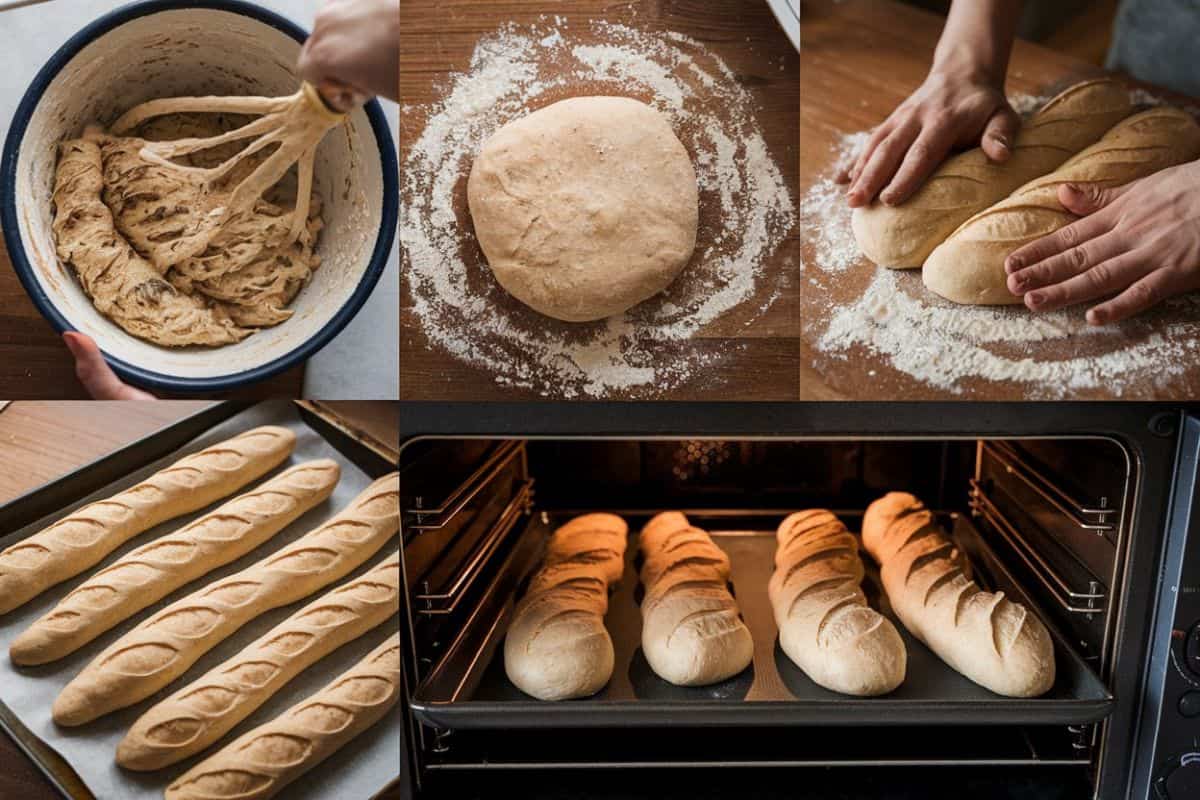
Activate the Yeast
Begin by activating your yeast. Mix the sugar, yeast, and warm water in a small bowl. Stir it gently and let the mixture sit for about 5–10 minutes. You’ll know the yeast is activated when it becomes frothy and bubbly on the surface. If it doesn’t foam up, your yeast may have expired, and you’ll need to start with fresh yeast.
Mix the Dough
Pour in the yeast mixture slowly, stirring with a spoon or on low speed in a mixer. Slowly pour in the yeast mixture and stir with a spoon or use the mixer on low speed. Add the olive oil if you’re using it, which will give the bread a slightly richer flavor. Continue mixing until a dough forms.
Knead the Dough
Kneading is essential for developing gluten, which gives the bread its structure and chewiness. If you’re kneading by hand, turn the dough onto a lightly floured surface and knead for about 8–10 minutes. The dough should become smooth, elastic, and slightly tacky. When utilizing a stand mixer equipped with a dough hook, knead on medium speed for 5–7 minutes.
Let the Dough Rise
After kneading, roll the dough into a ball and put it in a bowl that has been lightly oiled. Cover the bowl with a clean kitchen towel and let the dough rise for one to one and a half hours, or until doubled in size, in a warm location.
Shape the Dough
After the dough has risen, punch it down to release any air bubbles. Turn the dough onto a floured surface and divide it into two equal portions (for two baguettes). Shape each portion into a long, baguette-like loaf. You can use a baguette pan to help maintain the shape, or place them on a baking sheet.
Second Rise
Once shaped, cover the loaves again with a towel and let them rise for another 30–40 minutes until they puff up slightly.
Preheat the Oven
While the loaves are undergoing their second rise, preheat your oven to 450°F (230°C). To achieve a bakery-style crust, place an empty metal tray or cast-iron skillet at the bottom of the oven. This will be used to create steam.
Score the Loaves
Before baking, use a sharp knife or bread lame to make 3–4 diagonal slashes on the top of each loaf. This allows the bread to expand properly in the oven.
Bake the Bread
Arrange the loaves on the middle rack of the oven. Immediately pour about 1 cup of water into the hot tray or skillet at the bottom of the oven. The steam will contribute to a crust that is crunchy. For 20 to 25 minutes, bake, or until the loaves are hollow when tapped on the bottom and have a golden brown color.
Cool and Enjoy
After taking the bread out of the oven, let it cool for at least 15 minutes before slicing. Enjoy your homemade French bread with butter, jam, or as a side to any meal!
Tips for Perfecting Your French Bread
Even though this is an easy French bread recipe, a few tips can help you achieve an even better result:
- Use warm water: Water that’s too hot can kill the yeast, while cold water won’t activate it properly. Aim for water that’s around 110°F (45°C).
- Don’t over-knead: Knead the dough just until it’s smooth and elastic. Over-kneading can make the bread too dense.
- Create steam: The steam created by pouring water into a hot tray helps the bread form a crispy, crackly crust – a hallmark of good French bread.
- Slash the dough properly: Scoring the dough before baking not only looks professional, but it also helps the bread expand evenly in the oven.
Variations of French Bread
While the traditional French bread recipe is delicious on its own, you can also experiment with variations:
- Garlic French Bread: Add garlic and herbs to the dough for a flavorful twist.
- Whole Wheat French Bread: Substitute half the flour with whole wheat flour for a more wholesome version.
- Stuffed French Bread: Stuff the loaf with cheese or deli meats before baking for a savory snack.
Also Read: 10 Delicious Sourdough Discard Recipes
Serving Suggestions for Homemade French Bread
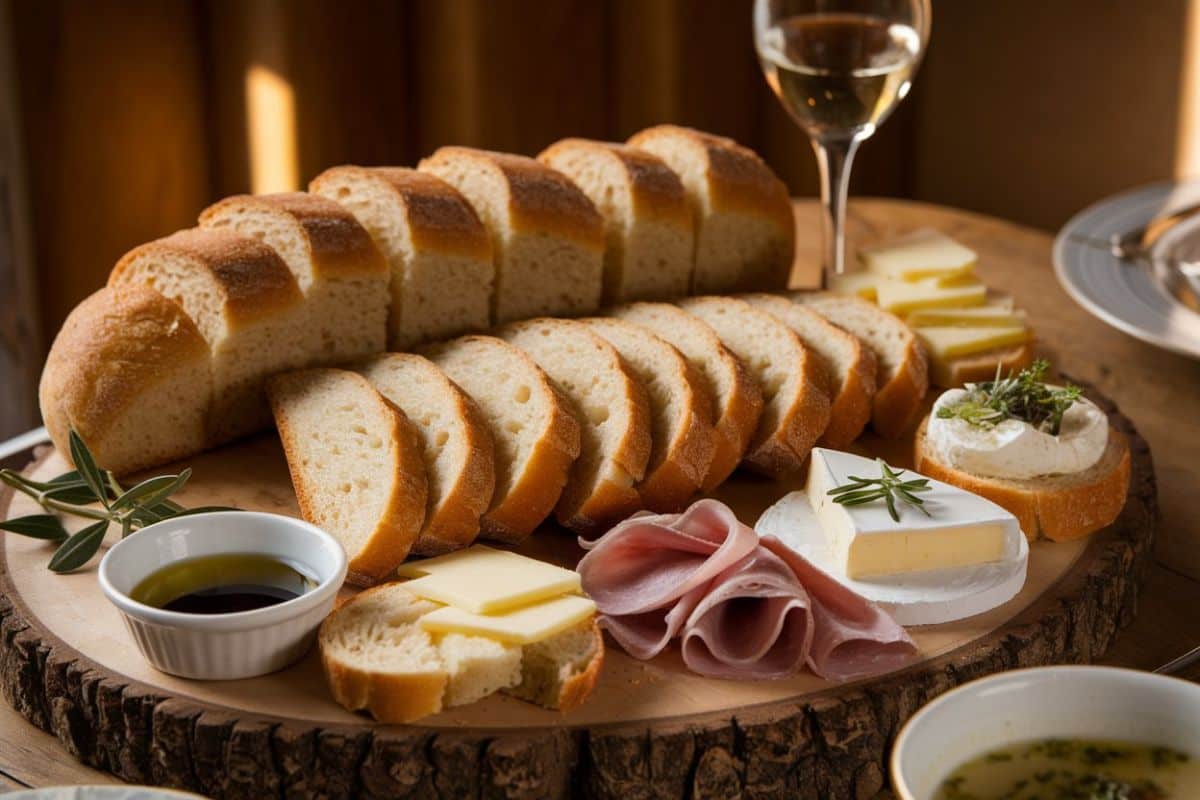
French bread is incredibly versatile and pairs well with a variety of dishes:
- Appetizer: Serve warm slices with olive oil and balsamic vinegar for dipping.
- Soup or Stew: Use it to soak up the broth in your favorite soup or stew.
- Sandwiches: Slice the bread lengthwise for a delicious sandwich base.
- Toast: Make French toast or crostini with leftover slices.
Conclusion
French bread baking at home can be a rewarding and surprisingly straightforward process. With just a few basic ingredients and some simple techniques, you can create a loaf that rivals anything found in a bakery. This easy homemade French bread recipe ensures that even novice bakers can achieve a crispy golden crust and soft, fluffy interior, perfect for any meal. The key is patience, proper kneading, and understanding the importance of steps like creating steam in the oven, which helps to produce that signature crunchy crust.
Whether you’re making bread for a family dinner, a weekend brunch, or simply for the joy of baking, mastering this French bread recipe will open up a world of possibilities in your kitchen. Not only will you have the satisfaction of creating delicious, authentic bread, but you’ll also be able to experiment with different flavors, shapes, and uses. From savory sandwiches to dipping slices into rich soups, this recipe provides a versatile base that will quickly become a household favorite. So take your time, enjoy the process, and relish the reward of fresh, warm French bread made from scratch.
Frequently Asked Questions (FAQs)
All-purpose flour works well, but bread flour can be used for a chewier texture and better structure due to its higher protein content.
To achieve a crispy crust, bake the bread with steam in the oven. You can create steam by placing a pan of water on the lower rack or misting the oven walls with water before baking.
Yes, French bread can be made entirely by hand. Kneading the dough by hand will take about 8-10 minutes until it’s smooth and elastic.
French bread is best eaten fresh on the day it’s baked, but it can be stored in a paper bag for 1-2 days. For longer storage, wrap and freeze it.
Yes, you can customize the recipe by adding ingredients like garlic, herbs, or even cheese for a flavorful twist on the classic French bread.

